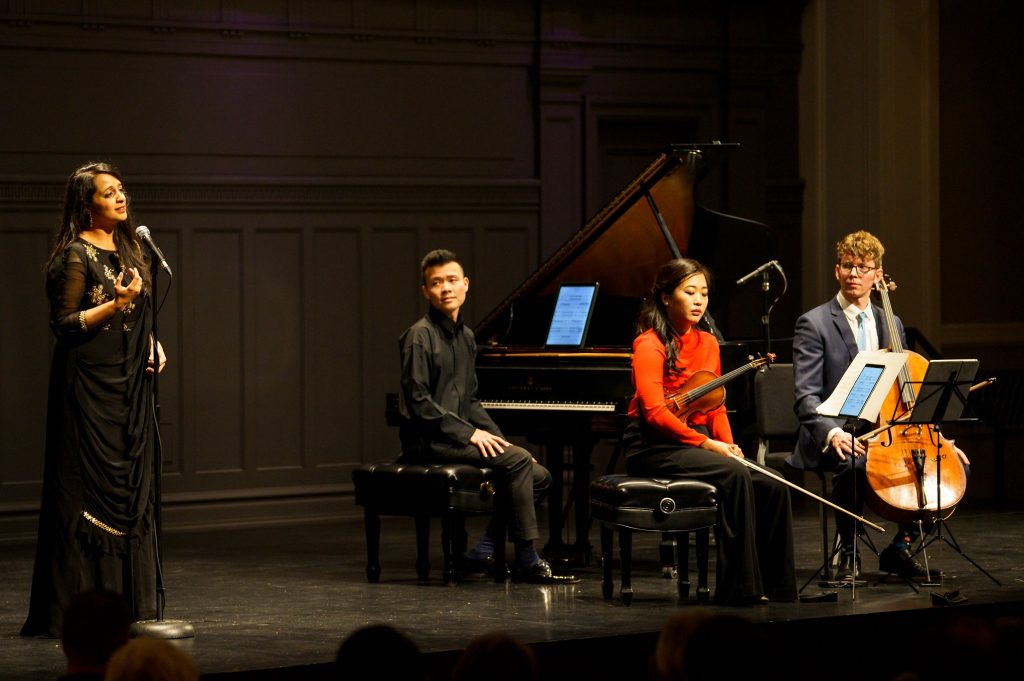
with Kristin Lee, violin; Joshua Roman, cello; David Fung, piano
Program Notes
these program notes were written by Aaron Grad, ahead of the premiere performance of the work, in November 2019
“I wish I could live in India and America at the same time,” says Reena Esmail (b. 1983), the daughter of Indian immigrants who has become one of the most respected young composers in the United States; “I wish they shared a border, and I could build a little home right in between them. I know I can’t do that in the physical world, but this is where I live every day in my music.”
Esmail’s compositions straddle two of the world’s most sophisticated musical traditions. On one side is the art music of Europe and its system of tonal harmony that developed over the last 400-plus years, and on the other, Hindustani classical music from North India, organized around collections of tones known as raags that go back many centuries further.
Studies at the Juilliard School and the Yale School of Music grounded Esmail in the practices of the West’s classical music, including its precise system of notation that allows performers of any background to interpret unfamiliar nuances. As a Fulbright-Nehru Scholar, she was able to spend a year in India studying the classical music of her ancestors, absorbing the oral tradition built on complex patterns and pitches that often can’t be categorized within Western norms.
Writing a Piano Trio has fulfilled one of Esmail’s oldest ambitions as a musician. Growing up as a talented pianist, trios with violin and cello were her favorite form of chamber music, and she won a life-changing competition that resulted in her performing Mendelssohn’s Second Piano Trio with members of the Los Angeles Philharmonic. She also counts Ravel’s Piano Trio as an all-time favorite work, noting,“So much of what I’ve learned about color and texture in my writing comes from Ravel.” After three years of work and a pile of sketches that is up to 300 pages and counting (with less that three weeks togo before the premiere), Esmail is still polishing off this substantial score that reckons with the rigorous tradition of the four-movement piano trio.
Authentic raags appear in each movement of the trio, including the monsoon season raag known as Megh that informs a chorale from the strings and other gestures in the first movement. In a tempo marked “Ephemeral,” the smooth modal phrases and long slurs highlight Esmail’s affinity with Ravel, who also looked outside the Western canon to expand his shimmering soundscapes. Flutters, slides and harmonics continue in the slow movement, creating a sense of improvisatory freedom while the music slips in and out of time.
By casting the quivering third movement as a scherzo, Esmail acknowledges her debt to Mendelssohn (the king of those elfin, lighter-than-air diversions), but moments of manic hilarity and sheer muscle recall a more subversive master of the piano trio, Shostakovich. In the finale, a singing string melody supported by “luminous” piano filigree surges to a droning climax marked “powerful, broad, intense.”
When the unhurried ending arrives with glimmering harmonics and crystalline chords, this work completes an arc that places it squarely within the storied lineage of the “classical” piano trio—while making it clear just how irrelevant such boundaries truly are.
(N.B. – please note that when listing movements of this trio in a program, the tempo markings are not intended to be listed as titles. Simply list the movements as I, II, III and IV)
Recording
(this is a playlist – click the upper right corner to hear the other movements)
Kristin Lee, violin; Joshua Roman, cello; David Fung, piano
recorded at Seattle Town Hall
Audio Guide
Full audio guides will be available in the future. If you are currently performing this work, please contact us for more information about audio guides.
A study score for this work is also available. When you purchase the score, please request it if you would like it.
Premiere/Performances
This piece was commissioned by Town Music Seattle. It was premiered on November 25, 2019 in Seattle, WA.
